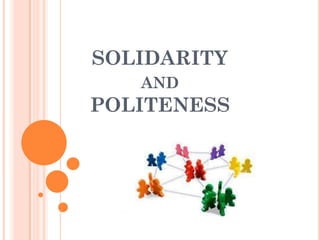
Solidarity and politeness
- 2. When we speak we have to make choices of many different kinds: what to say, when to say it, how to say it. How we say something is as important as what we say – Content and form are inseparable Some linguistics choices indicate the social relationship between speaker and listener.
- 3. TU AND VOUS This distinction began as a difference between plural and singular. IV century: the use of plural vous was to address the emperor. There were two emperors: one in Constantinople and another in Rome, but the Empire was administratively unified. By addressing one, you were in fact addressing both emperors. As a consequence, the medieval upper classes began to use V-forms among them to show mutual respect and politeness
- 4. Lower classes used mutual T –forms Upper classes used T to address lower classes, but received V addressing. Asymmetrical T/V usage symbolized a power relationship. Symmetrical V usage became “polite” usage, spreading downwards in society. It was used, for instance, between wife and husband, parents and children and lovers Symmetrical T usage showed intimacy. People using this for had strong common interests, showed solidarity.
- 5. Mutual T for solidarity gradually replaced mutual V for politeness Use of asymmetrical T/V decreased and mutual V was often used in its place. Nowadays, the right to initiate the reciprocal T belongs to the member of the dyad having the better power based claim to say T without reciprocation – an interesting residual of the power relation. If you cannot judge who has the power, settle for polite V usage! But…once a pair of speakers decide on mutual T, it is impossible to go back to either T/V or V/V usage.
- 6. ADDRESS TERMS How do you address people? By title? By first name? by last name? by nickname? By some combination of these?
- 7. Brown and Ford reported that: Asymmetrical use of title, last name and first name indicated inequality in power Mutual title, last name indicated inequality and unfamiliarity Mutual first name indicated equality and familiarity Switch from mutual TFL to FN is usually initiated by the most powerful member in the relationship. Address somebody by title is the least intimate form of address in that titles usually designates ranks or occupations Using another’s first name is a sign of considerable intimacy
- 8. Is the address process symmetrical or asymmetrical? Asymmetric use of names and address terms is often a clear indictor of a power differential. Examples: Children and teachers In the past, white people addressing black people People addressing the Queen or the President
- 9. In each country there are different rules stating how people should address each other. In England we can omit the address term when greeting someone but in France that avoidance could be impolite. As your family relationships change, issues of naming and addressing may arise; for example: how do you address your father/mother in law? Finally, an additional peculiarity is that people sometimes give names to, and address, non – human as well as humans, for example: how do you address your pets, if you have? And how do you address your kids or kids in general?
- 10. POLITENESS POLITENESS is socially prescribed, we adjust to others in social relationships in ways society deems appropriate IMPOLITENESS depends on the existence of standards
- 11. There are tow kinds of politeness: POSITIVE: we try to achieve solidarity and treat others as friends. We do not impose and never threaten their face. Example: symmetrical pronominal use NEGATIVE: it leads to deference, indirectness and formality in language use. Example: Asymmetric T/V use
- 12. Goffman (1955) states that when communicating “we present a FACE to others and to others’ faces.” In every social interaction we are obliged to protect both our own face and the face of others. We play out a kind of ritual in which each party is required to recognize the identity the other presents or claims. There is no faceless communication.
- 13. Brown and Levinson (1987) provide the definition of FACE “[it is] the public self-image that every member wants to claim for himself” They make a distinction between: POSITIVE FACE: it is the desire to gain the approval of others, the positive consistent self- image or personality. It looks to SOLIDARITY NEGATIVE FACE: it is the desire to be unimpeded by others’ actions; a claim for freedom of action and from imposition.
- 14. Each interaction is a FACE WORK and the goal is the maintenance of as much of each individual’s positive face as possible. Pinker (2007) argues that “politeness theory is a good start, but not enough [because] it assumes that the speaker and the hearer are working in perfect harmony, each trying to save each other’s face”